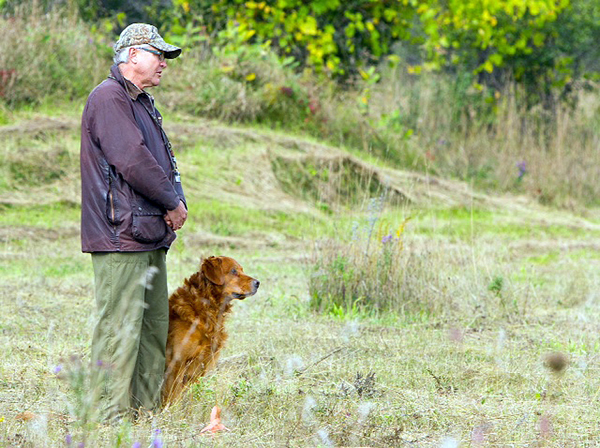GOOD DOG: An introduction
New Chronicle column focuses on dog training

This issue of the Manor Park Chronicle features the first in a new series of articles on dog training. The aim is to help owners ensure that their four-legged family members are obedient, well-mannered and happy.
The inspiration for this series comes from you — the many dog owners in Manor Park and surrounding neighborhoods. All of those I spoke with this past year, without exception, responded enthusiastically to the idea of a regular series on dog training. Many kindly offered excellent story ideas. Many also shared the same concerns respecting their dogs — like barking, house training, jumping, biting and chewing, recall and heeling on leash.
Training
Dog owners are finding that dog training can be a difficult and time-consuming exercise, often with disappointing results. But it need not be this way.
This series is based on three simple premises:
• firstly, that every dog is a good companion dog candidate;
• secondly, dog owners need to apply workable strategies that bring out the best in their dogs;
• and thirdly, should the services of a professional trainer be required, it is critical that they train not only the dog, but the owner and family members too.
My 50-plus year dog training apprenticeship has taught me that mistakes are inevitable, as are the occasional train wrecks. But what human psychology teaches us is that it is best to face life’s challenges head-on, build resilience, learn from failure and repair the damages. If you avoid challenges, your life, including living with your dog, does not get any easier.
Personal experience
There have been a lot of dogs in my life. I grew up with various mutts, beagles, and two hounds named Sam. As a student I held part-time and summer jobs with various small animal veterinary clinics, in Burlington, Ont. I started as a kennel boy but soon advanced to grooming, treatment, X-ray and surgical assistant.

After graduation Alison and I moved to Ottawa and soon-after welcomed our first golden retriever into the household. Judge was followed in subsequent years by Teal, Diesel and now Axle. All of our dogs were trained as both companion and working dogs — finding and retrieving downed grouse, woodcock, ducks and geese for the family table.
While dog training required a lot of time and hard work, it paid off, and not just in the field! In a series of judged tests, sanctioned by the Canadian Kennel Club (CKC), Judge was awarded his Companion Dog Obedience Certificate in 1984, placing first and second in two of the three qualifying tests. This was followed in 2013 when Diesel qualified for both Working Certificate and Working Certificate Intermediate in separate back-to-back CKC-sanctioned retriever hunt tests. His subsequent field performance over the years (he and I hunted waterfowl together) well-exceeded the requirements of these two awards. It was an honor to train and handle such a hard-working retriever.
Today my dog-training apprenticeship continues, now with Axle. At six years of age, he is an excellent companion dog and is well on his way to becoming a very respectable working retriever.
Throughout it all, we have benefitted tremendously from the advice of many others. For this Alison and I are eternally grateful. We particularly want to acknowledge our dear friend and mentor Mike Ducross, the owner of Ambertrail Kennels. Having trained with Mike, I can attest to the fact that he is a remarkable retriever trainer. Mike is also very highly qualified. He is the sole holder in the world of a World Class Triple Crown in dog obedience and field trials. He accomplished this with an exceptional dog named Push! We also want to thank our long-time veterinarian, Dr. John Swatman of Alta Vista Hospital. John has an affinity for working dogs and has played a critical role in helping us keep our dogs healthy!
Literature
In addition to mentors and veterinarians, dog training literature is also an important information source for both training and care. A lot has changed in the world of dog training since James Lamb Free, for example, first published “Training Your Retriever” in 1949. What we now know about dog learning, bonding and behavior, thanks to people like Dr. Ian Dunbar and others, is that early socialization and obedience training is critical to the successful development of any dog. The four books I recommend below are based on this contemporary understanding and are suitable for all breeds:
• The Complete Idiots Guide to Golden Retrievers, Nona Kilgore Bauer, 1999. Alpha Books, New York. (GT notes: Ignore the unfortunate title. This is a very comprehensive work on selection, training and care, though a copy may be hard to find).
• Let Dogs Be Dogs and The Art of Raising a Puppy, The Monks of New Skete, 2017/2011. Little Brown & Company, New York. (GT notes: Explores the good, bad and ugly of various training methods and lands on a balance that strengthens the dog/human bond while maintaining the essential leadership role that humans must play. The puppy text is full of how-to. Both are well illustrated.), and
• The Perfect Puppy, Gwen Bailey, 2024 edition, Octopus Publishing Group (GT notes: A very how-to book with wonderful illustrations and photos. Excellent, excellent, excellent!).
Future topics
In the coming issues of the Chronicle, we will explore: the human-dog bond; the attributes of a good companion dog; essential training equipment; the why and how of human leadership; training fundamentals; and, the how-to of basic obedience; and problem solving.
Of course, much will depend on reader feedback — with letters to the editor being encouraged. Additionally, Axle and I always have time for a road-side chat and impromptu demonstrations during our many daily walks in the neighborhood.
Until the next issue of the Chronicle, happy reading and keep up your training.


